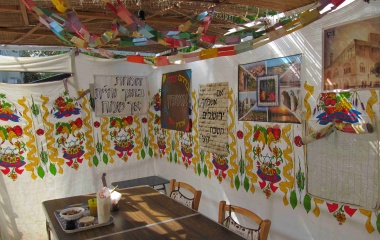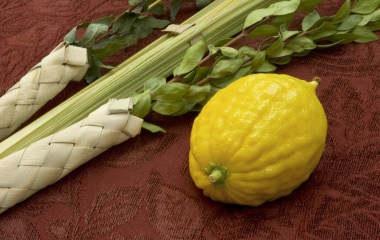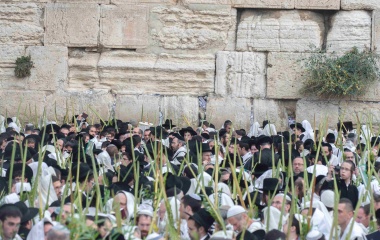
The arava, the willow branch, has a dual function on Sukkot. It is the last of four species that make up the mitzvah of “lulav”. Without this lowly branch, it makes little difference how beautiful the etrog may be—as without the arava, there is no mitzvah of etrog. It bears repeating that our Sages saw the four species as representing different types of Jews, with the arava representing the Jew who is neither learned nor observant. And yet, if such a person is rejected, the etrog—representing the learned, observant Jew—is rendered invalid.
But the arava is not just an afterthought to be included with the lulav and etrog (and hadas). It has its own independent identity on Sukkot. “The mitzvah of arava—how is it done? There was a place below Jerusalem, and it was called Motza. They would go down and gather branches of arava, and come and put them on the sides of the altar, and their tops would be bent over the altar[1]” (Sukkah 45a).
The source of the separate Temple mitzvah of arava is unclear, and the Gemara presents various possibilities. We are commanded to take a pri etz hadar, kapot temarim, and anaf etz avot—the lulav, etrog, and hadas—on Sukkot. All are written in the singular exceot the fourth species, the arvei nachal, which is written in the plural. While for the Rabbis, this served as the source that we need two aravot, for Abba Shaul it was a reference to two types of aravot, one for the lulav and one for the altar in the Temple. The Sages, in accordance with the rule that one can only derive one legal principle from a verse[2], maintain that the source for the arava is halacha leMoshe miSinai, an oral tradition with no scriptural basis.
After the destruction of the Temple, Rav Yochanan ben Zakkai ordained that we take the lulav for seven days to serve as a reminder of the practice in the Temple. Yet no such decree was issued in regard to the arava, which today is taken only on the seventh day of Sukkot. Rav Zvid explains that the arava is only a rabbinic mitzvah and thus, having a seven-day reminder is excessive. While the Gemara rejects this view, its basic premise remains: that since the mitzvah of arava is not explicitly mentioned in the Torah, the Sages felt a one-day reminder (i.e., Hoshanah Rabba) was enough.
Yet, this one day needed strengthening. “Why does the arava on the seventh day override the Shabbat? Rav Yochanan said: In order to publicize that it is from the Torah” (Sukkah 43a)—even if not explicitly mentioned. Not all were willing to accept this mitzvah. The Gemara relates how one year, the seventh day of Sukkot fell on Shabbat. Unable to cut the arava branches on Shabbat, they were brought on Friday to the Temple courtyard for use on Shabbat. The Boethusians—one of the various sects of Judaism that did not accept the Oral Law—knowing that, in accordance with the laws of muktza, the rabbis would not remove them from under stones, placed them under stones. Interestingly, the Gemara continues to explain how the ignorant who sided with the Sages (improperly) removed the aravot, and the kohanim did use them on that Shabbat.
The importance the rabbis attached to the arava can be seen in the workings of our calendar. Our present-day calendar is arranged in such a way that while Rosh Hashanah—and hence, Sukkot—can fall on Shabbat, Hoshana Rabba cannot. We may miss out on the biblical mitzvah of shofar and lulav, but not the custom of arava[3]. Surely shofar is more important than arava! The Tosafot (Sukkah 43b, s.v. lo ikla) explain that, even if we do not blow shofar, no one is going to say the mitzvah of shofar is unimportant. Yet if we were to cancel arava due to Shabbat, people would say that the arava is not so important, and may neglect it in future years[4].
The arava may consist of a lowly willow branch (perhaps adding an additional reason for its difficult acceptance as a mitzvah). Yet we worship G-d in simplicity. The Mishna records that, as Sukkot came to a close and people left the Temple, they would turn to the altar, adorned with the “lowly” arava, and proclaim, yofi lach mizbeach, yofi lach mizbeach, how beautiful the altar is, how beautiful the altar is.
_______________________________________________________
[1] “The lulav and arava is taken for six or seven days”(Sukkah 42b). In the days of the Temple, the lulav would be taken on Shabbat only if it fell on the first day, and the arava would be taken on Shabbat only on the seventh. So, depending on the calendar, the lulav and arava in any given year was taken for either six or seven days.
[2] Abba Shaul presumably follows the view of Rabbi Akiva (Sukkah 34b) that along with one lulav and one etrog we take only one hadas and one arava (Rosh).
[3] The biblical mitzvah of arava existed only so long as the Temple stood. The Gemara concludes that today, the taking of the arava is a “custom of the prophets” and as a custom, no blessing is said on observing such.
[4] Tosafot offers a second answer; namely, that both by shofar and lulav, even if we don’t observe them on Shabbat, we will do so on the next day. While this sounds very compelling, it does not explain why the Rabbis would cause us to miss out on the biblical mitzvah of shofar and lulav (on Sunday they are only rabbinic in nature) for the custom of arava, which was never a biblical mitzvah outside of the Temple.



